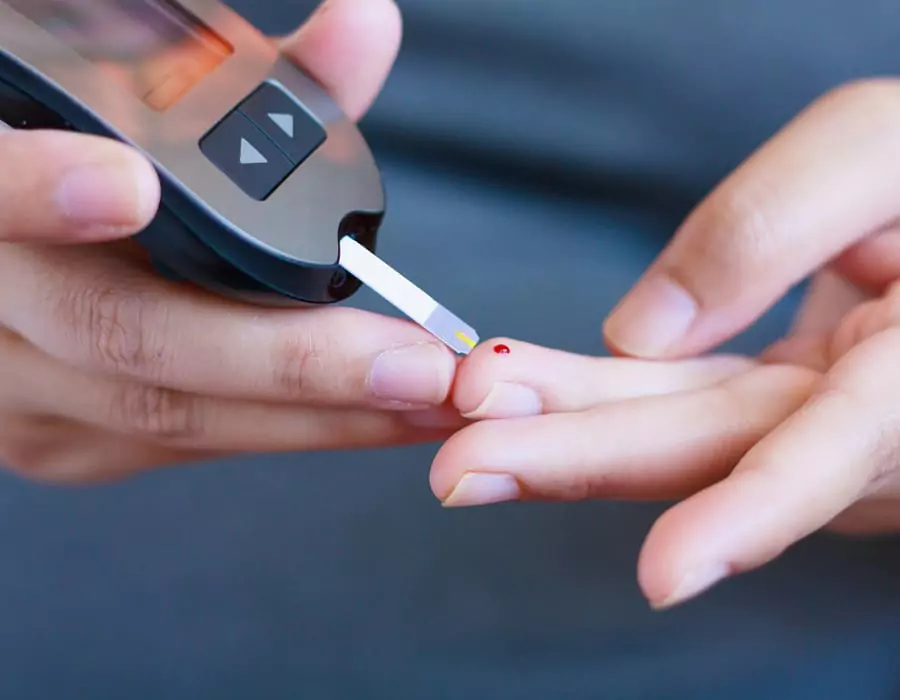DISCOUNT: UP TO 90% OFF






Why bother with finger stick Glucose Testing?


Table of Contents
- How often and why should I check my blood sugar for diabetes management?
- Self-monitoring of blood glucose provides immediate feedback and data
- Blood sugar checks may need to be performed more frequently in the following situations
- Other insights:
- Factors Which May Raise Blood Glucose
- Factors Which May Lower Blood Glucose
- Factors Which May Raise Blood Glucose
- Factors Which May Lower Blood Glucose
How often and why should I check my blood sugar for diabetes management?
We know and understand your struggles, your confusion and your misunderstandings about how to, why and how often to check blood glucose which is an essential component of proper diabetes management. Here are some facts you may want to know to understand how checking and being aware of blood glucose can improve your diabetes control.
- Self-monitoring of blood glucose plays a key role in supporting self- care behaviors and decision making.
- Self-monitoring of blood glucose provides people with diabetes the information they need to assess how food, physical activity, and medications affect their blood glucose levels.
- Structured blood glucose monitoring schedules are necessary in order to interpret the effects of food, physical activity, and medications on glycemic control.
- In addition to blood glucose monitoring providing data for glucose pattern management, continuous glucose monitoring (CGM) has become a useful tool for filling in glucose data gaps.
Self-monitoring of blood glucose provides immediate feedback and data
Obtaining and using blood sugar data help with the following;
- Achieving and maintaining target goals for blood glucose
- Preventing and detecting hypoglycemia (low blood glucose).
- Being aware of hypoglycemia unawareness by preventing and detecting hypoglycemia even when you do not feel hypoglycemic.
- Avoiding hyperosmolar hyperglycemic state (HHS) which is a condition that develops when blood glucose becomes too high such as above 600 mg/dl causing extreme dehydration and mental status changes.
- Evaluating the glucose response to types and amounts of food and physical activity
- Determining appropriate insulin- to-carbohydrate ratios, correction factors (how much insulin is needed to correct blood glucose such as 1 unit of insulin correcting 25 mg/dl of glucose suggest correction factor of 25), and basal insulin rates for intensive management (multiple daily injections and insulin pumps).
- Adjusting treatment in response to changes in lifestyle and the need to add, subtract, increase, or decrease dosages or types of pharmacologic therapies
- Determining the need for adjustment in insulin dosages during illness.
- Determining the need for insulin therapy in gestational diabetes.
Blood sugar checks may need to be performed more frequently in the following situations
- Identifying and treating hypoglycemia if on insulin or on agents that can lead to low blood glucose such as glipizide, glyburide, glimepiride.
- Making decisions concerning food intake or medication adjustment when exercising
- Determining the effect of food choices or portions on blood glucose levels.
- Managing intercurrent illness
- Managing hypoglycemia unawareness
- Prior to performing critical tasks, eg, driving. It is very important to check blood glucose before starting to drive and every 2 hours while driving.
- Monitoring recommended glucose control during preconception and pregnancy
From a practical point of view, the number of blood glucose checks performed per day is often based on the number of strips covered by health insurance plans. The following factors should be considered when helping individuals determine their testing frequency and time:
In type 1 diabetes and in individuals on a multiple daily insulin regimen, checking blood glucose levels 4 or more times per day is an accepted standard. typically, these individuals check glucose prior to mealtime insulin dosing. Additionally, postprandial glucose checks may be performed to monitor the glucose- rising effects of meals.
Any hypoglycemic (low glucose) symptom also warrants performing a blood glucose check. Some individuals check their glucose level prior to bedtime and before driving to ensure their safety.
More frequent monitoring is beneficial during insulin dose adjustment, illness, pregnancy, heavy periods of exercise or physical activity, and when an oral medication and/or injectable medication or insulin is prescribed.
There is little doubt of the value of self-monitoring of blood glucose for individuals who take multiple insulin injections per day, as the self-monitoring of blood glucose results are used to dose insulin or detect hypoglycemia. In fact, more frequent glucose testing is correlated with an improved hba1c level.
If you are a type 1 diabetic, 6–10 times per day self-monitoring of blood glucose to include: prior to meals and snacks, occasionally postprandially (after meals), at bedtime, prior to exercise, when hypoglycemia is suspected, after treating hypoglycemia until normoglycemic, prior to critical tasks such as driving.
For people with type 2 diabetes who are on multiple agents including insulin should test at least twice a day to 6–10 times per day to include: before meals, occasionally post-meal, before exercise or critical tasks such as driving, and at bedtime
For patients on intensive insulin regimen( taking long and short-acting insulins multiple times a day) should test 6–10 times per day to include: prior to meals and snacks, occasionally postprandially, at bedtime, prior to exercise, when hypoglycemia is suspected, after treating hypoglycemia until normoglycemic, prior to critical tasks such as driving On less intensive insulin therapy: more frequent SMBG (e.g., fasting, before/after meals) may be helpful, as increased frequency has been shown to be inversely correlated with glycemic control
Patients who are on only basal insulin (toujeo, lantus , Levemir, Tresiba, NPH) alone or with additional diabetes medications should test at minimum, fasting and at bedtime. If you are on basal insulin plus 1 daily mealtime insulin injection or premixed insulin injection you should test at minimum, fasting and before the pre-prandial or premixed insulin; periodically at other times such as premeal, bedtime, 3 a.m. additional testing before exercise or critical tasks, such as driving.
For patients with type 2 and Low risk of hypoglycemia such those patients who do not take insulin or sulfonylurea (glipizide, glimepiride or glyburide) should test once or less a day depending on the need the physician instruction.
Once at a1C goal, less frequent monitoring is acceptable.
Other insights:
An everyday 5- or 7-point blood glucose profile
(i.e., pre-prandial (before meals) and postprandial (after meals) plus bedtime blood glucose performed in 1 day) repeated for 5 to 7 days can provide insight as to when out- of-target blood glucose are occurring on a given day.
Staggered 2 or 3 blood glucose checks per day for 5 to 7 days
—whereby 1 mealtime is selected and premeal and post-meal blood glucose checks are performed can be useful in some patients who have limited supply of strips. A different mealtime is selected on subsequent days. Over the course of a week, the individual has 2 premeal and post-meal blood glucose values for each meal to evaluate in light of blood glucose goals.
Both the 5- or 7-point regimen and the staggered frequency regimen are considered meal- based regimens. Individuals can use the results from these regimens to gain insight into the effects of meals on blood glucose excursions.
3-point self-monitoring of blood glucose regimen
—whereby fasting, pre- largest-meal, and post- largest-meal blood glucose are taken—can be very helpful to an individual newly diagnosed with type 2 diabetes. This regimen provides information regarding glycemic control at fasting and the glycemic response to the largest meal of the day Ideally, individuals who find their post-meal blood glucose values out of target range will have the opportunity to work with a registered dietitian, who can evaluate the meal composition and corresponding blood glucose results to individualize a meal plan.
This approach is in stark contrast to what is often seen in non- insulin-using individuals with type 2 diabetes who are directed to check their blood glucose once a day, fasting, first thing in the morning. For individuals with type 2 diabetes whose fasting values are typically in the target range, checking only fasting blood glucose offers little insight into overall blood glucose control and, therefore, offers a false sense of glycemic control.
Last but now least, continuous glucose monitoring tools such as Dexcom, freestyle libre or guardian can help you monitor glucose values with less or no finger sticks. Those are typically more expensive than traditional meter and strips. You should check with your insurance provider about the coverage. Libre is relatively inexpensive yet Dexcom is more sophisticated and accurate. Please visit our blog about continuous glucose monitoring systems.
The process of reviewing glucose data can be made easier by encouraging persons to record the data in a logbook or with a smartphone app, with the testing time and results recorded in a linear and vertical fashion, or to download the data utilizing available software.
Factors Which May Raise Blood Glucose
- Inadequate insulin or oral medication dose- this happens when patients eat more than the insulin they take can handle or not correctly counting carbs.
- Other medications- consult with your doctor regarding this.
- Stress (dehydration, etc.)
- More carbohydrate than normally consumed at that time
Factors Which May Lower Blood Glucose
- Physical activity
- Too much insulin or oral medications
- Other medications- consult with your doctor regarding this.
- Physical activity- Physical activity depending on the intensity can lower your glucose significantly up to 24 hours following exercise.
- Fewer carbohydrates than normally consumed at that time-Patients who take a fixed amount of insulin may not match their insulin and carbs correctly. A diabetes coach can help you master this.
If you feel like you need help understanding or getting a better hold on your blood sugars, contact SugarMDs today. We're here for you 24/7, 365 to answer all of your diabetic concerns. To learn more about our services visit us at https://sugarmds.com/
Factors Which May Raise Blood Glucose
- Inadequate insulin or oral medication dose- this happens when patients eat more than the insulin they take can handle or not correctly counting carbs.
- Other medications- consult with your doctor regarding this.
- Stress (dehydration, etc.)
- More carbohydrate than normally consumed at that time
Factors Which May Lower Blood Glucose
- Physical activity
- Too much insulin or oral medications
- Other medications- consult with your doctor regarding this.
- Physical activity- Physical activity depending on the intensity can lower your glucose significantly up to 24 hours following exercise.
- Fewer carbohydrates than normally consumed at that time-Patients who take a fixed amount of insulin may not match their insulin and carbs correctly. A diabetes coach can help you master this.
If you feel like you need help understanding or getting a better hold on your blood sugars, contact SugarMDs today. We're here for you 24/7, 365 to answer all of your diabetic concerns. To learn more about our services visit us at https://sugarmds.com/
Written By Dr. Ahmet Ergin
461 total articles
Meet Dr. Ahmet Ergin, a highly skilled and dedicated endocrinologist with a passion for diabetes care. Dr. Ergin earned his medical degree with honors from Marmara University in Istanbul. He completed internal medicine residency and endocrinology fellowship at Cleveland Clinic. Dr. Ergin is board-certified in Internal Medicine, Endocrinology, Diabetes, and Metabolism due to his vast medical expertise. He's a certified diabetes educator, author of “The Ultimate Diabetes Book,” and founder of “the SugarMD YouTube channel.” Dr. Ergin offers exceptional diabetes care to his patients in Port Saint Lucie, FL, helping them manage effectively. For a closer look into his insights and experiences, connect with Dr. Ahmet Ergin on LinkedIn, Instagram, and YouTube.”
Disclaimer: These statements have not been evaluated by the Food and Drug Administration. Information on this website isn't intended to treat, cure or prevent any disease. Discuss with your doctor and do not self-treat.
Products















